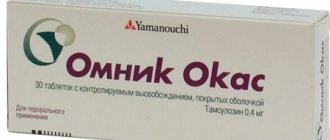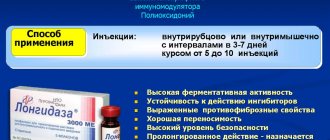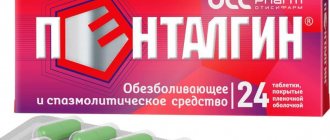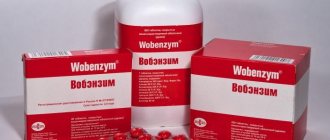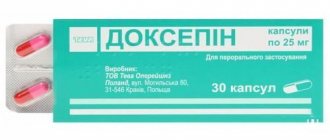| № | Name | Rating | Nomination |
| The best analogues of Omnic in composition | |||
| 1 | Tamsulosin | 4.66 | The most popular generic |
| 2 | Focusin | 4.22 | The most famous analogue |
| 3 | Proflosin | 4.07 | Best price |
| 4 | Sonizin | 4.05 | The best ratio of price and quality |
| 5 | Omsulosin | 4.00 | Good reviews from patients |
| The best analogues of Omnic in action | |||
| 1 | Urorek | 4.30 | Applicable for men and women |
| 2 | Setegis | 4.25 | The best analogue of Omnic for patients with hypertension |
| 3 | Cornam | 4.20 | Affordable price and efficiency |
| 4 | Alfuprost | 4.05 | The softest action |
| 5 | Duodart | 3.95 | Taking one medicine instead of two |
Omnic is a popular drug used to treat benign prostatic hyperplasia. This diagnosis is more familiar to men under the name prostate adenoma. The drug has a symptomatic effect and is prescribed in combination with other drugs. The active ingredient tamsulosin relaxes smooth muscles, relieves irritation of the urinary organs, significantly making the patient feel better. A big plus of the drug is that it can be taken by hypertensive and hypotensive patients due to the lack of a vasodilating effect on the cardiovascular system. Omnic is available in capsules, in packs of 10, 30 or 100 pieces. The registration certificate of the drug belongs to the Dutch company Astellas Pharma Europe, it is produced in the Netherlands and Russia. The cost of the drug is not prohibitive, but cheaper analogues in capsules and tablets, as well as substitutes based on other active ingredients that give a similar effect, can be found on sale. Comparison of rating participants by main characteristics:
| Name | Average cost for 30 capsules | Active substance | Manufacturer country |
| Omnic | 655 rub. | Tamsulosin | Netherlands |
| The best analogues of Omnic in composition | |||
| Focusin | 465 rub. | Tamsulosin | Slovakia |
| Proflosin | 362 rub. | Tamsulosin | Germany |
| Sonizin | 399 rub. | Tamsulosin | Romania |
| Tamsulosin | 502 rub. | Tamsulosin | Russia |
| Omsulolzin | 400 rub. | Tamsulosin | India |
| The best analogues of Omnic in action | |||
| Alfuprost mr | 715 rub. | Alfuzosin | India |
| Duodart | 1856 rub. | Dutasteride Tamsulosin | Germany |
| Urorek | 923 rub. | Silodosin | Italy |
| Setegis | 925 rub. | Terazosin | Hungary |
| Cornam | 420 rub. (20 tablets) | Terazosin | Slovenia |
There are contraindications! Consult your doctor!
pharmachologic effect
Manufacturer: Astellas Pharma Europe, BV, Netherlands
Release form: modified release capsules
Active ingredient: tamsulosin hydrochloride
Synonyms: Hyperprost, Glansin, Omnic Okas, Omsulosin, Proflosin, Sonizin, Tamzelin, Tamsulosin, Flosin, Omlos, Focusin
Omnic is an alpha-1 blocker that is widely used for benign prostatic hyperplasia in men. The mechanism of action is the selective blocking of adrenergic receptors in the smooth muscle layer of the prostate, bladder, and urethra. In response to this effect, the outflow of urine improves and spasm in the urinary tract and prostate decreases. The effects of using the drug and its full analogues begin to appear 14 days after the start of therapy.
5α-reductase inhibitors
This is the second group of drugs for the treatment of symptoms of BPH and CP, which block the reaction of the conversion of testosterone to dihydrotestosterone, which causes changes in the prostate gland.
Active ingredients of the group
- dutasteride;
- finasteride.
The peculiarity of therapy lies in the duration of continuous use of the medication.
The effect of treatment is observed in a pronounced increase in the maximum speed of urination, a decrease in the risk of developing acute urinary retention and a decrease in prostate volume.
However, a group of 5a-reductase inhibitors causes some undesirable reactions: erectile dysfunction, depression, decreased libido, enlarged mammary glands in men (gynecomastia).
Omnik - instructions for use
Omnic is taken orally. The medicine is prescribed one capsule per day after breakfast. The duration of treatment is selected individually
The manufacturer recommends taking the medication at the same time in the instructions for use.
The medicine is not used in patients under 18 years of age, as well as in case of allergies to the components of the drug, orthostatic hypotension and liver failure.
The most common adverse reactions are dizziness and ejaculation disorders. Hypotension, headaches, nasal congestion, allergies, and visual disturbances are rarely observed. The product is used only in men.
Analogues of Omnik
Complete analogues of Omnic include the following drugs:
- Glansin;
- Omnic Okas;
- Proflosin;
- Hypersimple;
- Omsulosin;
- Sonizin;
- Tamsulosin;
- Focusin;
- Tamzelin;
- Omlos;
- Flosin;
- Tamsulon;
- Adenorm;
- Prostate;
- Taniz-K;
- Tamsulostad.
Such drugs are characterized by an identical composition, differ in manufacturer, cost, and are a good alternative when looking for something that can replace Omnic.
Substitutes for Omnic with similar pharmacological effects are the following:
- medications based on alfuzosin - Alfuzosin, Alfuprost, Alfuzosin, Dalfaz;
- drugs based on doxazosin - Artezin, Artezin retard, Doxazosin, Kamiren, Kardura, Urocard;
- based on terazosin - Kornam, Setegis, Terazosin;
- products based on silodosin - Urorek;
- homeopathic remedies - Afalase;
- herbal medicines, analogs of Omnic without serious side effects - Prostamol Uno, Permixon, Prostatoff, Prostaplant, Peponen, Vitanorm, Bioprost;
- products based on finasteride - Finasteride, Alfinal, Penester, Proscar, Prosteride, Finast;
- analogues based on dutasteride - Dutasteride, Avotard, Dutasterone, Duodart;
- products based on prostate extract - Vitaprost, Prostatilen;
- other drugs used in the treatment of prostatitis that have a pronounced anti-inflammatory effect - Longidaza, Adenoprostin, Azaran, Polyoxidonium, Prostacor, Samprost.
Such imported or domestic analogues of Omnic differ in composition and application features, release forms (capsules, suppositories, tablets, solutions), manufacturers and mechanisms of action. The choice of a substitute should be entrusted only to the attending physician in order to exclude possible complications of symptomatic therapy. Most of these drugs are prescription drugs.
Omnic analogues and average cost
| Drug name | Active substance | Release form | Manufacturer | Minimum dosage cost |
| Omnic | Tamsulosin | Extended-release capsules | Astellas Pharma Europe, BV, Netherlands | From 260 rub. |
| Tamsulosin | Vertex JSC, Russia | From 380 rub. | ||
| Focusin | Saneca Pharmaceuticals, Slovakia | From 420 rub. | ||
| Proflosin | Rottendorf Pharma GmbH, Germany | From 345 rub. | ||
| Omnik Okas | Controlled-release tablets | Astellas Pharma Europe, BV, Netherlands | From 240 rub. | |
| Urorek | Silodosin | Capsules | Recordati Ireland Ltd., Ireland | From 745 rub. |
| Prostamol Uno | Saw Palmetto (Saw Palmetto) Fruit Extract | Capsules | RP Scherer GmbH&Co, Germany | From 725 rub. |
| Afalaza | Antibodies to endothelial NO synthase, antibodies to prostate-specific antigen | Lozenges | Materia Medica Holding NPF, LLC, Russia | From 600 rub. |
Omnic or Urorek
Manufacturer: Recordati Ireland Ltd., Ireland
Release form: capsules
Active ingredient: silodosin
Synonyms: Silodosin
Urorek is a very close analogue of Omnic for urinary disorders due to prostatitis and prostate adenoma. The product contains the adrenergic blocker silodosin, which is characterized by very high selectivity towards the tissues of the prostate, bladder and urethra. Urorek allows you to more effectively eliminate the symptoms associated with prostate adenoma. The drug allows you to eliminate ureteral obstruction and discomfort in patients over 18 years of age in a shorter time.
Urorek dosages for men differ and are 4-8 mg/day. This substitute is better tolerated. The most common adverse reaction is only impaired ejaculation.
Study of the degree of uroselectivity of the drug Omnic (tamsulosin) and its generic analogues
Introduction
In recent years, there has been a persistent worldwide trend towards increasing the share of generic drugs in the pharmaceutical market [1].
Let us recall that generic or reproduced drugs are drugs that are identical in all respects to the original drug, in terms of quality and quantity of constituent ingredients, dosage and bioequivalence, which are produced without a license from the manufacturer of the original drug and are released onto the market after the expiration of patent protection or other exclusive rights. An original drug is a drug that was synthesized for the first time and has undergone a full cycle of preclinical and clinical studies, representing an undoubted step forward in any pharmacotherapeutic group. The process of its creation is very expensive, since it begins with the synthesis of the molecule, continues in experimental studies on animals (the severity of the pharmacological effect, toxicity, mutagenicity, teratogenicity is studied) and ends with tests on healthy volunteers and patients suffering from the disease for which the drug is being created. After the patent expires, the medicine becomes an international property, i.e. The active principle of the drug and its dosage forms can be legally reproduced by other companies. Of course, original drugs are reproduced only if, during the period allotted by patent protection, they have confirmed their high efficiency and practical value in clinical studies and wide clinical practice. This is precisely the selection criterion for reproduction by other companies. The equivalence of generic and original drugs is a pressing issue, discussed not only by manufacturing companies (which is quite natural), but also by practitioners, health care and drug supply organizers. Evidence of the therapeutic effectiveness of the original drug is obtained in comparison with placebo or a reference drug of the corresponding pharmacological group in large multicenter clinical trials involving hundreds and sometimes thousands of patients. The production of generics, on the one hand, makes it possible to reduce the cost of a drug and increase the availability of drug care. However, we must not forget that the cost of generics is less than that of a brand due to the use of inexpensive substances and packaging materials, changes in the quantitative and qualitative composition of excipients, which largely determine the pharmacokinetic parameters and safety profile of the drug [1]. The significantly lower cost of a generic may be due to the fact that by producing a generic after the patent protection period for the original drug has expired, the company does not conduct large and expensive studies to prove the effectiveness of the active ingredient [2]. In accordance with existing legislation, preclinical and clinical studies are not required to confirm the effectiveness and safety of a generic drug. Today, the volume of sales of generic drugs in the world continues to increase, amounting to about 25% in the USA, 35% in Germany, 55% in the UK and Hungary, 78% in Russia, 61% in Poland, 66% in Slovakia. It is impossible to say unequivocally that the “dominance” of generics is characteristic only of developing countries, however, in post-socialist countries the share of generic drugs is indeed greater than in Western Europe (the exception is the UK). The purpose of our study was to conduct an experimental comparative assessment of the “uroselectivity” of the original drug tamsulosin (Omnic) and its generic analogues (Hyperprost, Revokarin, Tamsulon-FS and Fokusin), since uroselectivity determines the clinical effectiveness and safety of tamsulosin in patients with benign prostatic hyperplasia (BPH). First, a few words about BPH, a-blockers and uroselectivity. According to the literature, symptoms of BPH can appear at 40–50 years of age [3] and are found in almost half of men who have reached the age of 60 [4]. These data are confirmed by the results of histological studies: signs of BPH are found in 50% of men aged 60 years and in 9 out of 10 men over 80 years of age [5]. In our country, epidemiological studies have shown that at the age of 40–49 years, the incidence of BPH occurs in 11% of cases, and at the age of 80 years, the prevalence of the disease reaches 81% [3]. More than a hundred years ago, the first attempts at surgical treatment of BPH were made, and currently urologists have at their disposal a large number of methods for the surgical correction of urinary disorders in BPH. The “gold standard” for surgical treatment of BPH around the world is transurethral resection of the prostate (TURP). The data we have today eloquently demonstrates that even a well-performed TURP does not always meet the patients’ expectations, can be accompanied by serious intra- and postoperative complications and does not guarantee the patient from the need for reoperation after some time [5]. In recent years, drug therapy for urinary disorders caused by BPH has been increasingly used. On the one hand, this is due to the emergence of new drugs, and on the other hand, with the expansion of indications for drug therapy and the simultaneous possibility of monitoring patients. Currently, the first choice of drug therapy for patients with BPH accompanied by symptoms of urinary dysfunction (LUTS) are alpha1-adrenergic blockers (a1-blockers).
The effectiveness and safety of treatment with this group of drugs has been proven in numerous international and domestic randomized multicenter clinical studies for more than 10 years [6].
a-Adrenergic blockers (a-AB) act on a-adrenergic receptors (a-AR) and, by exerting a blocking effect, improve the symptoms of dynamic obstruction that underlie the complaints of patients with BPH. With the help of pharmacological and molecular biological studies, scientists were able to identify three subtypes of a1-AR: a1A, a1B and a1D. a1A-Adrenergic receptors are located in the tissue of the prostate gland and prostatic urethra and account for about 70% of all a1-ARs in this area. a1D-ARs are located in the bladder and its innervating organs. a1B-Subtype is located in the walls of large blood vessels. Thus, the selectivity of the drug to the a1A subtype of adrenergic receptors (in other words, its uroselectivity) determines the positive effect in the treatment of BPH. The activity of the a1B subtype explains fluctuations in blood pressure (BP) and, accordingly, the presence of side effects when using drugs of this group in urological patients. The higher the affinity of the drug for the α1A subtype of adrenergic receptors, the greater its uroselectivity [6]. Studies on selective subtypes of a1-receptors contributed to the emergence of a new drug from the a-AB group, characterized by a superselective effect on the a1A receptor subtype - tamsulosin. Having equal effectiveness with other drugs in this group, tamsulosin is devoid of the hypotensive effect, which is the reason for fewer side effects that occur during its use. This feature allows tamsulosin to be prescribed without prior dose titration, which is required for most α1-ABs [7]. Tamsulosin: brief pharmacokinetic characteristics
Tamsulosin reduces the tone of the smooth muscles of the prostate gland, bladder neck, prostatic urethra, improves urine outflow, reduces symptoms of obstruction and irritation of the urinary tract in BPH. The therapeutic effect of the drug develops after 2 weeks. This is achieved through selective blockade of postsynaptic a1A-ARs of the smooth muscles of the prostate gland, bladder neck and prostatic urethra. The ability to block a1A-AR is 20 times greater than the effect on a1B-AR in vascular smooth muscle (the effect on systemic blood pressure is negligible). After oral administration, tamsulosin is almost completely absorbed from the gastrointestinal tract (GIT) - absorption is more than 90%. Binding to blood plasma proteins (mainly a1-glycoprotein) is 94–99%, distributed throughout the volume of blood and extracellular fluid (volume of distribution 0.2 l/kg). It is slowly biotransformed in the liver with the participation of cytochrome P-450 with the formation of active metabolites (they retain selectivity for α1A-AR), and circulates in the plasma mainly unchanged. T1/2 – 9–13 hours in healthy volunteers, 14–15 hours in patients during treatment. Eating increases bioavailability and Cmax, and reduces the time to reach Cmax. Cmax is achieved after 4–5 hours (when taken on an empty stomach) or 6–7 hours (when taken with food). The equilibrium concentration is established by the 6th day of course administration, its peak values are 60–70% higher than Cmax after a single oral dose. It is excreted primarily by the kidneys in the form of conjugates of metabolites with glucuronic and sulfuric acids (10% unchanged), partially with feces [8].
Materials and methods
Phase 1
of this study was to experimentally conduct a comparative assessment of the uroselectivity of the original drug tamsulosin (Omnic) and its generic analogues (Hyperprost, Revokarin, Tamsulon-FS and Fokusin), since uroselectivity determines the clinical effectiveness and safety of tamsulosin in patients with BPH.
The selectivity of tamsulosin to a1-AR and specifically a1A-a1D subtypes has been proven in a number of experimental studies [9]. In phase 1 of our study, we compared the relative affinity of the selective antagonists
tamsulosin for α-AR and the magnitude of the inhibition constant in rat prostate and aortic tissue.
Phase 2.
Phase 2 assessed the comparative ability of test samples of tamsulosin to displace labeled prazosin from the complex with α1-AR in patient biopsies.
The work used biopsy material from 25 patients with BPH. The purpose of this study was to evaluate the parameters of specific binding of a-AR ligands of prostate biopsies from patients with BPH with the original drug tamsulosin Omnic
(ZAO Astellas Pharma) and generic drugs of tamsulosin.
Extraction of the active substance (tamsulosin) from capsules
Each capsule of the studied drugs (A – E) was placed in 50 ml of dissolution medium, previously thermostated at a temperature of 37±0.5°C. Hereinafter, tamsulosin obtained from the studied drugs is designated by the following code: (A) – Omnic; (B) – Hyperprost; (C) – Revocarin; (D) – Tamsulon-FS; (E) – Focusin. 5 hours after the start of incubation, aliquots of 1 ml of solution were taken. Mixer rotation speed 100 rpm. The volume of dissolution medium is 50 ml. The temperature of the dissolution medium is 37±0.5°C. Dissolution medium: 6.8 g of monopotassium phosphate and 1.4 g of sodium hydroxide per 100 ml of double-distilled water. Bring the volume of the solution to 1000 ml and mix. A solution is obtained whose pH value is about 7.2. The amount of tamsulosin transferred into the dissolution medium was determined by high-performance liquid chromatography.
Assessment of specific binding of a-AR ligands
Rat prostate tissue homogenates were incubated in the presence of various concentrations of [H3]prazosin in a medium containing 50 mM Tris-HCl buffer (pH 7.5) for 30 min at 25°C according to the method described by S. Yamada et al.
(J Pharmacol Exp Ther 1987;242:326–30). The reaction was stopped by filtration with Whatman GF/B. Specific binding of labeled prazosin was determined as the difference between the radioactivities of samples with and without 10 μM phentolamine. [H3]Prazosin (3.03 TBq/mmol) produced in this work was used. Determination of the relative affinity of selective antagonists
of the studied a-ARs (X) Occupation of a-ARs by the studied compounds was calculated using the formula:
RO (%) = [(Bmax(control) – Bmax(X)/Bmax(control)]i100,
where X is the substance under study.
The value of the inhibition constant
(Ki) was calculated using the formula:
Ki = IC50/1+L/Kd),
where IC50 is the concentration of the test sample (X), at which the number of prazosin complexes with AR is 50% of the control values (in the absence of X in the incubation medium); L – equilibrium concentration of labeled prazosin; Kd is the equilibrium dissociation constant of the prazosin–AR complex, equal to 68±10 nM.
Study results
Phase 1
In the first series of experiments, selective binding ability was determined - this indicator reflects the ability of tamsulosin drugs to selectively bind to a1-AR. For this purpose, two test systems were used: in one, the object of study was a homogenate of rat prostate tissue (a1A-AP), in the other, a homogenate of rat thoracic aortic tissue (a1B-AP). The results obtained are presented in table. 1.
As can be seen from the formula for calculating Ki, there is a direct relationship between the drug concentration at which the number of prazosin complexes with AR is 50% of the control values, and the value of the inhibition constant (Ki). That is, the higher the concentration of the drug required to displace prazosin from communication with the receptors, the higher the Ki value and the lower the affinity of the drug for a1A-AR. And, accordingly, the lower the Ki value, the more pronounced the affinity of tamsulosin for a1A-AR. As shown in the figure, the minimum Ki value and, accordingly, a greater value of uroselectivity is characteristic of Omnic, and the smallest is characteristic of Focusin. It can be seen that all studied samples exhibit high tropism towards the a1A subtype of prostate AR - Ki values in the first test system (prostate tissue samples - a1A-AR) are 2-3 times less than in the second test system (aortic tissue – a1B-AR). In other words, the affinity of the studied compounds for the a1B subtype of AR of aortic smooth muscle cells is significantly lower. In the second series of experiments, the comparative ability of the tested samples to displace labeled prazosin from the complex with a1-AR of the prostate and aorta was assessed. The experimental data are summarized in table. 2.
When assessing relative binding capacity, the degree of a1A-AP occupancy will be higher, the higher the RO value. Accordingly, as shown in the figure, Omnic has the highest degree of a1A-AR occupancy, lower values are typical for Hyperprost, Revocarin and Tamsulon, and Focusin has the lowest affinity. It was found that the ability of the studied samples to displace prazosin in different test systems differs significantly. Depending on the selective binding activity, assessed by the RO value, the studied samples are arranged in the following row (rat prostate): Omnic > Tamsulon-FS > Hyperprost > Revocarin > Focusin. In the aorta of rats, no significant differences in the relative binding capacity were obtained. Based on the results of the study, the following conclusions were made: 1. All studied samples have tropism towards the a1A subtype of rat prostate AR. 2. The affinity of the studied samples for rat prostate AR, assessed by the Ki value, is in the range of 2.2–3.2 nM, no significant differences were noted. 3. Depending on the selective binding activity, assessed by the RO value, the studied samples are located in the row: Omnic > Tamsulon-FS > Hyperprost > Revocarin > Focusin. 4. In in vitro experiments, the studied samples have a similar affinity for the a1A receptors of the rat prostate, but differ in their ability to competitively displace the labeled prazosin of their complex with AR. The data obtained indicate possible differences in the pharmacological effectiveness of the tested tamsulosin preparations under in vivo conditions. Phase 2
As is known, the results of experimental studies performed on animals cannot always be extrapolated to the human population.
Therefore, we considered the experimental study as a pilot project, and immediately after receiving the first results, we planned to conduct a study to study the interaction of a1A-AR of prostate biopsies from patients with BPH with the original and generic drugs of tamsulosin. The purpose of this study was to evaluate the parameters of specific binding of a-AR ligands of prostate biopsies from patients with BPH with the original drug tamsulosin - Omnik
(ZAO Astellas Pharma) and generic drugs tamsulosin -
Revokarin
(Pharmproekt, Russia),
Fokusin
( "Zentiva", Czech Republic),
Hyperprost
(MakizPharma, Russia) and
Tamsulon-FS
(Pharmsintez, Russia)." When assessing relative binding capacity, the degree of a1A-AP occupancy will be higher, the higher the RO value. Accordingly, as can be seen from the table. 3 results, the original drug Omnic has the highest affinity for a1A-AR. Depending on the level of prostate-specific antigen (PSA), patients were divided into 3 groups; the data obtained are summarized in table. 3. The highest affinity of tamsulosin (Omnic) among the studied samples was observed in all three groups of patients.
In the group of patients with BPH and PSA level <4 ng/ml, the value of the relative binding capacity, reflecting the degree of a1A-AR occupancy, was maximum for Omnic; significant differences were obtained when comparing Omnic with Hyperprost and Revocarin. In the second group of patients with PSA levels in the range of 4.0–10 ng/ml, the highest value of the degree of a1A-AR occupancy was also characteristic of Omnic. Omnic was found to have a significantly higher relative selective ability compared to Hyperprost and Revocarin (see figure).
The third group included patients with a PSA value >10 ng/ml. It was not possible to obtain significant differences between the drugs, which is probably due to the small number of samples. However, the previously identified trend persisted - the maximum value of tamsulosin affinity for a1A-AR was again shown for the original drug. Thus, the results of the study allowed us to conclude that the original drug Omnic had the maximum selective binding capacity in all three groups compared to other generic tamsulosin drugs. Depending on the selective binding activity, assessed by the RO value, and the PSA level, the studied tamsulosin samples were located in the following order: PSA<4.0 ng/ml: A>E>D>C>B; 4.0≤PSA<10 ng/ml: A>E>D>B>C; PSA≥10.0 ng/ml: A>D>E> B>C.
Conclusion
The increasing share of generic drugs in the modern pharmaceutical market, along with their price attractiveness, forces us to look for ways to rationally assess the comparability of original drugs, which with the maximum degree of reliability could indicate the high quality of the reproduced sample. It is known that studying only biological equivalence does not always indicate comparable therapeutic equivalence of a drug and a similar safety profile. Conducting large-scale clinical studies to study the comparative effectiveness of the original drug and its generics is not always possible. One alternative may be to study the affinity of drugs for receptors. A series of comparative studies to study the binding of tamsulosin preparations (the original drug Omnik and its generics) with a-AR made it possible to establish differences in the uroselectivity of tamsulosin preparations. The original drug tamsulosin Omnic was characterized by maximum affinity for a1A-AR, both in terms of the relative binding activity of tamsulosin and the values of the inhibition constant. Obviously, for greater clinical significance of scientific results, further studies are needed to study the uroselectivity of tamsulosin drugs in patients with BPH in in vivo conditions.
Omnic or Focusin
Manufacturer: Saneca Pharmaceuticals, Slovakia
Release form: modified release capsules
Active ingredient: tamsulosin
Synonyms: Hyperprost, Sonizin, Glansin, Omsulosin, Proflosin, Tamzelin, Tamsulosin, Flosin, Omnic Okas, Omlos, Omnic
Focusin is a complete analogue of Omnik, the price of which is higher. This imported substitute should be taken orally, 1 capsule/day. The duration of treatment is determined by the doctor. Replacing with this drug will maximize the effectiveness of therapy.
This remedy eliminates urinary disorders caused by prostate hyperplasia, reduces discomfort in patients and improves quality of life.
Omnic or Omnic Okas
Manufacturer: Astellas Pharma Europe, BV, Netherlands
Release form: controlled-release film-coated tablets
Active ingredient: tamsulosin
Synonyms: Hyperprost, Glansin, Omnic, Omsulosin, Proflosin, Sonizin, Tamzelin, Tamsulosin, Flosin, Omlos, Focusin
Omnik Okas is a complete analogue of Omnik, which costs a little less. Both products are produced by the same imported manufacturer. The difference between analogues is in the release forms. Omnic Okas is produced in tablets with controlled release of tamsulosin with the same amount of active ingredient 400 mg.
The drug is not used to treat patients under 18 years of age. At the beginning of therapy, the drug may cause a decrease in blood pressure, resulting in weakness and dizziness. The duration of treatment is selected individually depending on the effectiveness of the treatment and the severity of the disease.
Top 3. Cornam
Rating (2021): 4.20
Affordable price and effectiveness At a low cost, Cornam relieves inflammation and pain well, and relieves difficulty urinating. An accessible analogue helps to quickly improve well-being with prostatitis.
- Characteristics
Average price: 420 rub.
- Manufacturer: Lek (Slovenia)
- Active ingredient: terazosin
- Release form: tablets
The cheapest Omnic substitute, despite its affordable price, acts quickly and effectively. Available in tablet form in dosages of 2 mg and 5 mg. It is often prescribed to patients with a persistent increase in blood pressure, since in addition to relieving spasms of smooth muscles, it has a pronounced hypotensive effect. Used for inflammatory processes and prostate hyperplasia. Quickly facilitates urination and relieves pain. The main advantage of the drug is its affordable price, the main disadvantage is the impossibility of prescribing for hypotension. Use with caution when treating patients with diabetes mellitus, angina pectoris, renal and liver failure.
Advantages and disadvantages
- Affordable price
- Fast action
- Makes urination easier
- Relieves pain and inflammation
- Significantly lowers blood pressure
See also:
- 10 best remedies for prostatitis with iHerb
Omnic or Tamsulosin
Manufacturer: Vertex JSC, Russia
Release form: extended-release capsules
Active ingredient: tamsulosin
Synonyms: Hyperprost, Glansin, Omnic, Omsulosin, Proflosin, Sonizin, Tamzelin, Flosin, Omlos, Focusin
Tamsulosin is a substitute produced by the domestic company Vertex. The product has a completely identical composition, dosage of the active substance and release form. Tamsulosin, as it passes through the prostate tissue, relaxes the muscle layer of the urinary tract, which stimulates and facilitates the outflow of urine in patients over 18 years of age. A sharp decrease in blood pressure is possible in patients when starting to take this analogue. This condition requires caution when taking capsules. For men taking Tamsulosin and its full analogues, if they experience weakness and dizziness, it is recommended to lie down for a while.
Sources
- NEW APPROACHES IN CONSERVATIVE THERAPY OF BENIGN PROSTATE HYPERPLASIA https://elibrary.ru/item.asp?id=27381607
- EXPERIENCE IN TREATING CHRONIC PROSTATITIS USING THE DRUG AFALA https://elibrary.ru/item.asp?id=23697963
- D.Yu.Pushkar, Yu.B.Belousov, P.I. Rasner, A.S. Dukhanin, O.A. Maneshina. Study of the degree of uroselectivity of the drug Omnic (tamsulosin) and its generic analogues. Journal of Consilium Medicum. 2009; 7: 66-69. Electronic version: https://www.fesmu.ru/elib/Article.aspx?id=208330
- COMPARATIVE ANALYSIS OF VARIOUS COMBINATION THERAPY OPTIONS IN PATIENTS WITH BPH https://elibrary.ru/item.asp?id=35093311
- A.V. Govorov, G.R. Kasyan, A.O. Vasiliev, D.Yu. Pushkar. Tadalafil in the treatment of lower urinary tract symptoms: a review of the literature and current clinical practice in Russia. Journal of Consilium Medicum. 2014; 07: 33-41. Electronic version: https://www.fesmu.ru/elib/Article.aspx?id=302742
- I.A. Korneev. Erectile dysfunction: features of diagnosis and drug treatment of men with concomitant diseases. Journal of Consilium Medicum. 2015; 07:24-28. Electronic version: https://cyberleninka.ru/article/n/erektilnaya-disfunktsiya-osobennosti-diagnostiki-i-medikamentoznogo-lecheniya-muzhchin-s-soputstvuyuschimi-zabolevaniyami/viewer
Share:
Omnik or Proflosin
Manufacturer: Rottendorf Pharma GmbH, Germany
Release form: capsules with prolonged action
Active ingredient: tamsulosin
Synonyms: Hyperprost, Glansin, Omnic, Omsulosin, Sonizin, Tamzelin, Flosin, Omlos, Focusin, Omnic Okas, Tamsulosin
Proflosin is a more expensive full analogue of the active substance from a German manufacturer. The drugs are completely identical and are often used as replacements for each other. The choice of an alternative remedy should be entrusted to a doctor. The product is not used to treat patients under 18 years of age.
The drug is taken once a day in the morning after breakfast. The capsule must not be opened, crushed, or dissolved, since the system for releasing the active substance is disrupted and the effectiveness of treatment with Proflosin is reduced.
Omnic or Glansin
Manufacturer: Higlance Laboratories Pvt.
Ltd., India Release form: modified release capsules
Active ingredient: tamsulosin
Synonyms: Hyperprost, Omnic, Omsulosin, Sonizin, Tamzelin, Flosin, Omlos, Focusin, Omnic Okas, Tamsulosin, Proflosin
Glansin is classified as a complete analogue of the active substance. The product relaxes the smooth muscles of the prostate and urethra, improving the flow of urine. Long-term use of this substitute often significantly relieves symptoms of the disease and delays surgery for patients over 18 years of age.
The most common side effect is dizziness, which improves after using the product for several days in a row. It is also possible to develop ejaculation disorders, which does not require discontinuation of the drug.
Medical recommendations
Now no one doubts that treating BPH is not enough to only reduce symptoms. It is also very important to prevent the progression of the disease. For this purpose, combination therapy is most effective.
However, the first line of choice remains the group of alpha1-blockers, the prescription of which requires taking into account the patient’s age and concomitant diseases (hypertension, cardiovascular disorders). If the size of the prostate gland is 40-50 cm³ or more, then it is necessary to include 5a-reductase inhibitors in therapy.
The treating urologist must monitor the course of the disease so as not to miss the point that requires more active treatment of BPH and CP, including surgical intervention if necessary.
Omnic or Prostamol Uno
Manufacturer: RP Scherer GmbH&Co, Germany
Release form: capsules
Active ingredient: saw palmetto (creeping) palm extract
Synonyms: Permixon, Prostatoff, Prostaker, Prostaplant
Prostamol Uno and its analogues are preparations based on plant raw materials - extract of palm tree. The product differs not only in its composition, but also in its mechanisms of action and manufacturer. Prostamol capsules should be taken once a day, preferably in the morning.
This drug is very well tolerated and is characterized by a high level of safety and very low toxicity. The doctor will advise which remedy is most effective, taking into account the severity of the disease and the general condition of the patient.
Omnic or Duodart
Manufacturer: GlaxoSmithKline Trading, Germany
Release form: modified release capsules
Active ingredients: dutasteride, tamsulosin
Synonyms: Dutasteride T, Dutasteride/Tamsulosin
Duodart is an analogue of Omnic with a combined composition. The product contains tamsulosin, which is part of Omnic, and dutasteride, which is an inhibitor of a specific reductase enzyme. Thanks to this complex of active components, the medicine has a stronger and more pronounced effect on the smooth muscles of the prostate and urethra. This analogue also blocks the production of dihydrotestosterone, which is the main cause of prostate tissue proliferation and adenoma formation.
The most common adverse reactions are dizziness and ejaculation disorders in men. Duodart is not used to treat patients under 18 years of age or women.
Combination drugs
Studies have been carried out on the etiopathogenetic effects of drugs from different groups, individually and in combinations. The effectiveness of the combined use of drugs from the α1-AB group and 5a-reductase has been clinically proven. In all studies, the effect of drugs with each other is stronger than of any one drug (Source No. 4).
Combination therapy can be sequential or parallel.
Duodart or Omnic
The study convincingly proved that the combined drug Duodart was more effective than therapy with two separate drugs Omnic and Finasteride. Duodart is a combination drug with fixed doses of tamsulosin and dutasteride, a new second-generation 5a-reductase inhibitor with a unique mechanism of action (Source No. 1).
